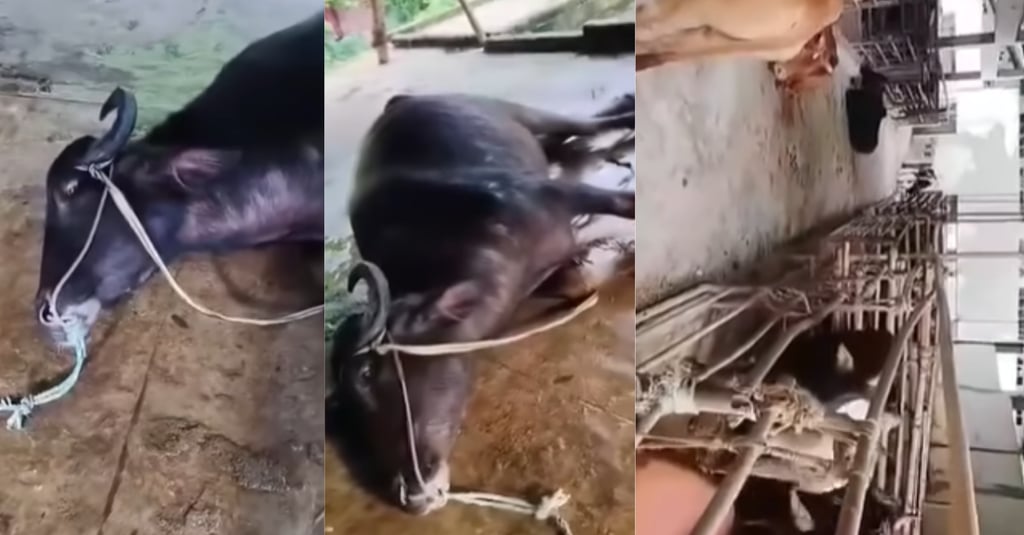Neglect at slaughterhouse in Sikkim; injured buffalo struggles for survival
Bishwakarma expressed deep concern over the apparent negligence. “A buffalo was left in extremely poor condition and its health has worsened over time.
LOCAL


Concern has been raised over the shocking condition of a buffalo found in severe distress at a local slaughterhouse in Majitar, Pakyong district. Ramu Bishwakarma, a member of People For Animals and a well-known animal welfare activist, brought the issue to light questioning the lack of proper supervision and accountability at the facility.
Bishwakarma expressed deep concern over the apparent negligence. “A buffalo was left in extremely poor condition and its health has worsened over time. Its body is swollen, and injuries are visible all over. Even our elders are concerned about how the animal is being cared for,” he said. Bishwakarma also questioned why the concerned authorities were not fulfilling their duties and why the checkposts along the supply route failed to flag the animal’s condition, particularly when the buffalo was visibly injured on one leg.
Veterinary inspection revealed the seriousness of the situation. According to sources on the ground, a local veterinarian examined the buffalo carefully and noted multiple injuries and damaged flesh, especially on its legs. Attempts to provide treatment in the enclosure proved difficult. The buffalo, weak and in pain, struggled to cooperate, while the presence of snakes and other small creatures around the enclosure complicated care efforts.
The buffalo had likely been suffering for several days without proper attention. Immediate intervention was deemed necessary, including proper wound care, hydration, and continuous monitoring. Caretakers and the veterinarian worked together to provide the necessary support, but it became clear that without ongoing attention, the buffalo’s condition could deteriorate further.
“Despite its weak condition, the buffalo is trying to stand. The caretakers and the doctor are doing their best. Continuous care is essential for its recovery,” Bishwakarma said.
The case also raises questions about adherence to legal regulations regarding animal slaughter in Sikkim. The Sikkim Prevention of Cow Slaughter Act, 2017, strictly prohibits the unauthorized slaughter of cows and related livestock. The Act was formulated to ensure that all animal slaughter is carried out legally and humanely, with penalties for violations including imprisonment and heavy fines.
The Act clearly stipulates that any slaughter must be authorized by a competent authority and accompanied by valid documentation. Its provisions highlight the importance of lawful practices in animal handling, particularly for bovine animals, which are given special protection under state law. Failure to follow these rules can have serious legal consequences, underscoring the state’s commitment to animal welfare and responsible livestock management.
Despite these regulations, the Majitar incident suggests gaps in enforcement and monitoring. Local activists, including Bishwakarma, insist that checkposts and slaughterhouses must strictly follow the Act to prevent cruelty and unlawful practices. They also advocate for regular inspections, proper record-keeping, and mandatory reporting of animal health issues.
This case is also a reminder of the broader challenges in livestock management across the state. Reports of animals being transported in poor conditions or being left unattended in slaughterhouses have surfaced sporadically over the years. Experts argue that systematic monitoring, combined with strict enforcement of the Sikkim Prevention of Cow Slaughter Act, can significantly reduce instances of animal cruelty.
Bishwakarma highlighted that the local community also has a role to play. “People who transport or handle animals must be aware of their responsibilities. Ignoring an animal’s suffering is not just unethical; it is a violation of the law,” he said. Animal rights activists are calling for awareness campaigns, public engagement, and stricter penalties for negligence, believing that community involvement is key to effective enforcement.
The Sikkim Prevention of Cow Slaughter Act, 2017, further emphasizes that any violation of its provisions; whether unauthorized slaughter, neglect, or mistreatment can attract legal action. The law also recognizes the necessity of proper facilities for slaughter, ensuring that humane methods are followed and animals are not subjected to unnecessary pain. In light of the Majhitar incident, these guidelines are more relevant than ever.
